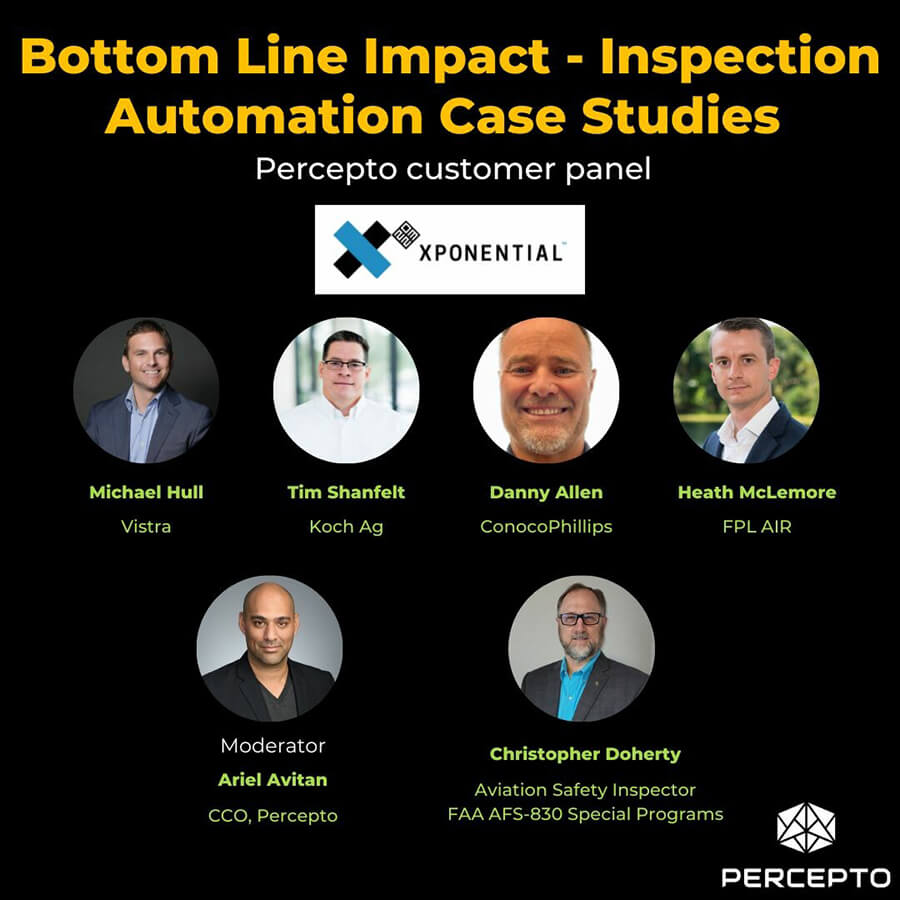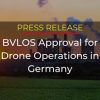Highlights from the Percepto panel discussion at Xponential 2023
How is the regulatory approach to drone inspections at industrial sites changing? How are some of the biggest industrial companies using drones? What’s the impact of moving to autonomous inspection, and how is that changing the value equation?
Four top inspection executives at Fortune 500 companies and an official with the Federal Aviation Administration (FAA) addressed those questions, and more, when they joined Percepto for a panel discussion at Xponential 2023. Their comments were riveting. For some top-level insights, read this summary of the highlights. Or watch the recording of the discussion to get the full picture from these thought leaders.
Insights shared by:
- Chris Doherty, FAA – Aviation Safety Inspector, currently working for the AFS-830 Waiver Team evaluating complex Part 107 Waiver applications
- Heath McLemore, Florida Power & Light – Responsible for emerging UAS technology integrations, part of a team that conducts up to 400 UAS flights a day
- Michael Hull, Vistra Corp – Director of Generation Technology, responsible for technology at gas, coal, solar and storage sites
- Tim Shanfelt, Koch Ag and Energy Solutions – Director of Operations Transformation, focusing on digital transformation strategy
- Danny Allen, ConocoPhillips – Geospatial intelligence supervisor, oversees analysis, data, and intelligence

Discussion highlights
How is the FAA’s approach to waivers for infrastructure inspection evolving?
The FAA’s Chris Doherty has been instrumental in working with Percepto and companies to streamline beyond visual line of site (BVLOS) regulations to facilitate safe industrial inspection. For example, on the eve of Xponential 2023, Percepto was granted the first-ever nationwide FAA waiver for true BVLOS operations in shielded airspace, without humans onsite and without expensive ground-based systems.
Chris explained the FAA’s approach regarding this latest waiver, and waivers in general. He said that Xponential 2022, where he and his team met with Percepto and others and saw our infrastructure inspection solutions, was a turning point.
Chris Doherty, FAA:
“ We had sat down with you at your booth, Ariel, for about 45 minutes while we ran through all the aspects of your equipment. So what we took away from Xponential was we needed to do a better job. And so we started taking a really risk-based approach to this. What’s the risk of somebody flying 200 feet next to a nuclear reactor? If that’s happening, we’ve got other issues, right? … And we’re asking the industry to actually push us more into forward-thinking so we can kind of stay ahead of the curve about getting all of these waivers out for these particular operations.”
How are industry leaders using drones for inspection?
The industry panel members described their drone inspection activities, how that has evolved, and where they hope to go from here. Together, they paint a broad picture of some of the key use cases across varied industries.
Heath, Florida Power & Light:
“Today, we’re running anywhere from 400 to 600 drone flights a day across, not just in Florida, but across the U.S. under our parent company, NextEra Energy Resources. So, the team’s quickly growing, we’re continuing to learn new things every day as we continue the path of the waivers and the future of highly autonomous drone operations.”
Michael, Vistra Corp:
“For about three years, we’ve had a drone program exclusively on the fossil side, so coal plants, gas plants, primarily doing pre-outage inspections, just looking for maintenance activities that would need to be done, nothing very revolutionary. We also use it in our mining side to do pit progressions, but it’s with the solar and bringing on utility solar sides, is where we’re starting to see the expansion and growth.”
Danny, ConocoPhillips:
“We own and operate our own substations and utility lines. Being able to inspect that infrastructure is critical to our operations. We kind of rolled into facility inspections, tower inspections, and now we’re doing fugitive emission inspections.”
Tim, Koch Ag & Energy:
We use [drones] to eliminate the four Ds: the dirty, dangerous, difficult, and disinteresting work that the men and women in our plants have to do on a daily basis. That’s everything from battery limit blind inspections during turnarounds, lay down yard inspections, [to] security rounds.”
How have autonomous capabilities changed your inspection programs?
Freeing people to do other tasks rather than flying and managing drone missions. Getting actionable insights quickly. Being able to cost-effectively conduct inspections far more frequently. Improving safety. According to the panelists, those are just a few of the big differences felt when inspections go autonomous.
Tim, Koch Ag & Energy:
“The autonomous side has really freed up a large chunk of that 4D work to just be scheduled work. … It’s all pre-programmed and it goes and flies, and it accomplishes those missions. And then when we have a one-off, we can either take our manual drones or we can manually fly the Percepto drone. That’s been big, because most of our folks at our plants have their day job, and drones typically are something that they do on the side. … They’re receiving the reports through the AIM system and the value is being generated that way instead of people having to be fully dedicated to being in a drone program.”
Danny, ConocoPhillips:
“We go out, we spend all the time collecting this information, and then we give it to the teams to review, and they just don’t have the time or the capacity to review it. So this [autonomation] was more along the ways of optimizing efficiency, being able to give that data back to the business and make actionable insights.”
Danny also noted that the addition of optical gas imaging (OGI) during autonomous inspection missions has had a huge impact:
“In a manual operation, you send a pilot out to the field with a drone, with a payload, an optical gas imaging camera. They physically have to set everything up, do their safety procedures, cool the camera, do those inspections manually… So, you’re driving back to the office, you’re uploading that data, and now you introduce a whole other aspect of reviewing all that data. So, we’re looking at about a three-day time span before we can inspect something and give a report. … [Now] we’re able to generate those reports, give those reports back to the team the next morning, and they can go and do the repairs.”
Michael, Vistra Corp:
“Previously, we would contract out [solar] inspections once a year … and we found there was way too much stuff going wrong for us to find in those inspections. So, we knew one year was way too infrequent to do an inspection over a solar field. Our contractor said, ‘Great, we could do it four times a year for four times the cost.’ [But] that’s not going to work. Autonomy allows us to flip the model of how you cost out an inspection.”
Heath, Florida Power & Light:
“We’re always looking for ways to automate and replace … daily repetitive, redundant [tasks]. … And when doing that, [replacing] with automation, you can increase safety. … Whatever we can do to eliminate the human element is going to make that operation much safer. Also, you know, on our path to automating, now we’re able to potentially reduce the number of participants in a lot of our operations.”
How are BVLOS waivers enabling companies to scale their inspection programs?
With increasing FAA waivers relating to BVLOS, inspection is becoming more autonomous; less dependent on humans being onsite. The forum speakers shared how that is enabling them to scale their inspection programs and gain more value, going beyond time and cost savings.
Michael, Vistra Corp:
“The cost-per-inspection model has completely flipped. It used to be if we wanted to get inspection data and good information about where our opportunities are, we had to pay for it. … Now that we’re completely autonomous running out of [our control center in] Dallas. It’s changed to ‘how can I be flying these drones more frequently? What else can I be doing to generate value?’ … It allows us to truly scale across the country as we build out our portfolio of solar operations. … We’ve completely eliminated the marginal cost for doing the asset inspections out there.”
Tim, Koch Ag & Energy:
“The flip of the concept of cost to value is huge. Instead of looking at the technology and the reports from a perspective of how much they cost, [asking] ‘how do we minimize cost?’, once you have the system in place, it’s ‘how can we continue to unlock more and more value?’. Once you start to look at the value side of the equation, there is infinitely more potential than the cost-cutting side. The automation and the BVLOS have helped us, and the regulatory framework has freed us up to start looking for more and more value opportunities.”
More insights
The discussion delved into more depth on each of the above questions. And it covered other hot topics in autonomous inspection, how autonomous inspection can improve employee safety, and experts’ tips for companies that are just getting started with a drone inspection program. You can see the full discussion here.





